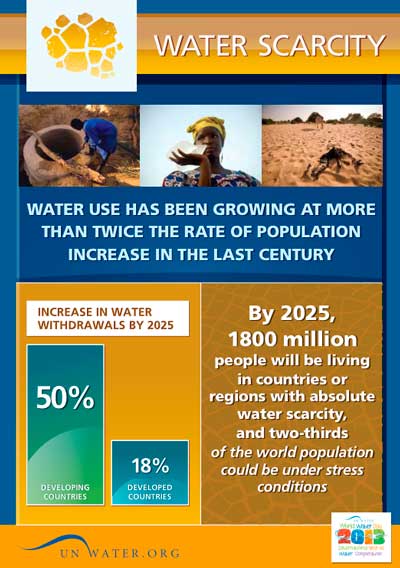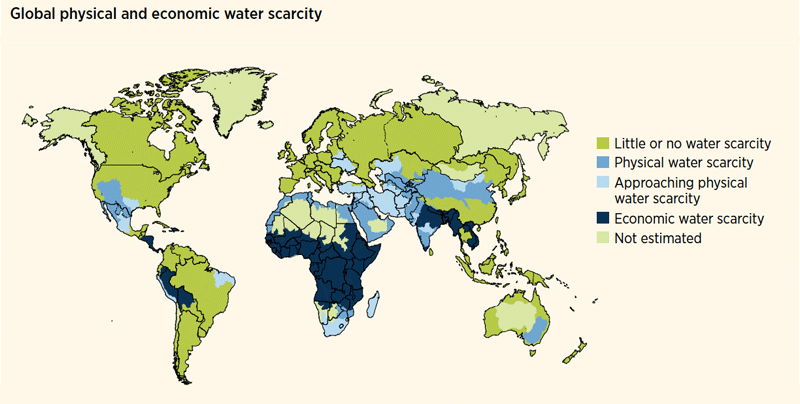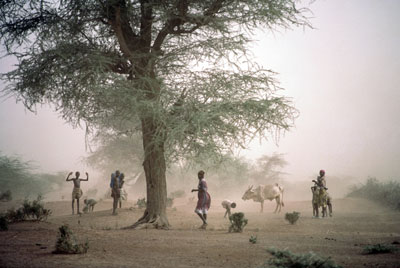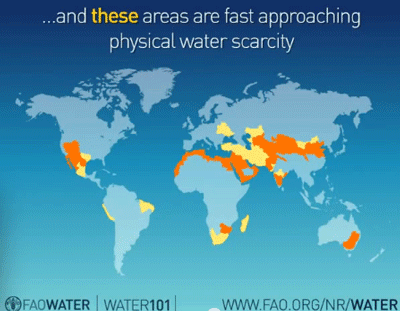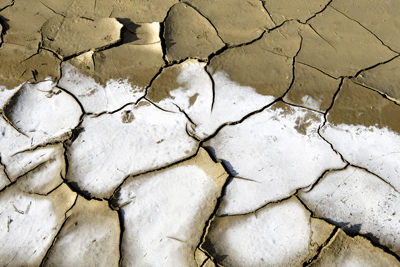- ON THE DECADE
- THE DECADE'S CAMPAIGN
- REPORTING ON PROGRESS
- THE DECADE'S PROGRAMMES
- FOCUS AREAS
-
- Access to sanitation
- Financing water
- Gender and water
- Human right to water
- Integrated Water Resources Management
- Transboundary waters
- Water and cities
- Water and energy
- Water and food security
- Water and sustainable development
- Water and the green economy
- Water cooperation
- Water quality
- Water scarcity
- FOCUS REGIONS
- RESOURCES FOR
- UN e-RESOURCES
Water scarcity
Water scarcity already affects every continent. Around 1.2 billion people, or almost one-fifth of the world's population, live in areas of physical scarcity, and 500 million people are approaching this situation. Another 1.6 billion people, or almost one quarter of the world's population, face economic water shortage (where countries lack the necessary infrastructure to take water from rivers and aquifers).
Water scarcity is among the main problems to be faced by many societies and the World in the XXIst century. Water use has been growing at more than twice the rate of population increase in the last century, and, although there is no global water scarcity as such, an increasing number of regions are chronically short of water.
Water scarcity is both a natural and a human-made phenomenon. There is enough freshwater on the planet for seven billion people but it is distributed unevenly and too much of it is wasted, polluted and unsustainably managed.
Sources:
- Human Development Report 2006. UNDP, 2006
- Coping with water scarcity. Challenge of the twenty-first century. UN-Water, FAO, 2007
Water scarcity and the MDGs
The way water scarcity issues are addressed impacts upon the successful achievement of most of the Millennium Development Goals:
- MDG 1: Access to water for domestic and productive uses (agriculture, industry, and other economic activities) has a direct impact on poverty and food security.
- MDG 2: Incidence of catastrophic but often recurrent events, such as droughts, interrupts educational attainment.
- MDG 3: Access to water, in particular in conditions of scarce resources, has important gender related implications, which affects the social and economic capital of women in terms of leadership, earnings and networking opportunities.
- MDGs 4 and 5: Equitable, reliable water resources management programmes reduce poor people's vulnerability to shocks, which in turn gives them more secure and fruitful livelihoods to draw upon in caring for their children.
- MDG 6: Access to water, and improved water and wastewater management in human settlements, reduce transmission risks of mosquito-borne illnesses, such as malaria and dengue fever.
- MDG 7: Adequate treatment of wastewater contributes to less pressure on freshwater resources, helping to protect human and environmental health.
- MDG 8: Water scarcity increasingly calls for strengthened international cooperation in the fields of technologies for enhanced water productivity, financing opportunities, and an improved environment to share the benefits of scarce water management.
Water stress versus water scarcity
Hydrologists typically assess scarcity by looking at the population-water equation. An area is experiencing water stress when annual water supplies drop below 1,700 m3 per person. When annual water supplies drop below 1,000 m3 per person, the population faces water scarcity, and below 500 cubic metres "absolute scarcity".
Water scarcity is defined as the point at which the aggregate impact of all users impinges on the supply or quality of water under prevailing institutional arrangements to the extent that the demand by all sectors, including the environment, cannot be satisfied fully. Water scarcity is a relative concept and can occur at any level of supply or demand. Scarcity may be a social construct (a product of affluence, expectations and customary behaviour) or the consequence of altered supply patterns - stemming from climate change for example.
Did you know?
- Around 700 million people in 43 countries suffer today from water scarcity.
- By 2025, 1.8 billion people will be living in countries or regions with absolute water scarcity, and two-thirds of the world's population could be living under water stressed conditions.
- With the existing climate change scenario, almost half the world's population will be living in areas of high water stress by 2030, including between 75 million and 250 million people in Africa. In addition, water scarcity in some arid and semi-arid places will displace between 24 million and 700 million people.
- Sub-Saharan Africa has the largest number of water-stressed countries of any region.
UN initiatives that are helping to raise the issue...
- World Water Day 2007: Coping with water scarcity
World Water Day 2007 was dedicated to the theme "Coping with water scarcity". It highlighted the increasing significance of water scarcity worldwide and the need for increased integration and cooperation to ensure sustainable, efficient and equitable management of scarce water resources, both at international and local levels. - World Day to Combat Desertification 2013
The theme of the 2013 World Day to Combat Desertification is drought and water scarcity. This year's slogan, "Don't let our future dry up", calls for everyone to take action to promote preparedness and resilience to water scarcity, desertification and drought. The slogan embodies the message that we are all responsible for water and land conservation and sustainable use, and that there are solutions to these serious natural resource challenges.
To know more
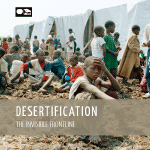 Desertification, the invisible frontline
Desertification, the invisible frontline
United Nations Convention to Combat Desertification (UNCCD). January 2014
This publication examines desertification as a cause of global conflict and instability and calls for urgent action to support communities in crisis. It explores the impacts desertification has on the lives of many under the titles: Food (in)security – farming ourselves into extinction; Water (in)security – water scarcity triggers conflicts; Climate – changing the face of the earth changes the humanity; Migration – fight or flee; National Security – breaking down; Inaction, recipe for International Political and Economic chaos; Securitizing productive land – securing peace and stability; Investing in large scale restoration initiatives; Drought management measures; Institutional reforms; and culminates with Taking action now, a summary on what we can do now, to secure a future capable of dealing with drought risk.
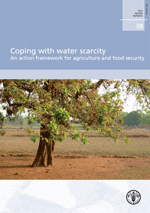 Coping with water scarcity. An action framework for agriculture and food security
Coping with water scarcity. An action framework for agriculture and food security
Food and Agriculture Organization of the United Nations (FAO). August 2012
This report focuses on the importance of the drylands issue on the global agenda and its relation to other issues, including climate change, food security and human settlements. The report illustrates the many ways in which the UN system is identifying opportunities to mainstream the drylands agenda into the policy-making process. It sets out a common vision and agenda for UN-wide action on dryland management and its role in addressing climate change and food security through a positive development and investment approach. The report is aimed at a number of audiences, with certain objectives: (1) UN agencies themselves, to clarify the commitment made to drylands and act as a reference guide; (2) Governments of developed and developing countries, as a normative guide on the UN's position on, and commitment to, the development of drylands; (3) The private sector and donors, to encourage and inspire them to think about the viability and unique opportunities presented by drylands, and (4) Civil society, to encourage advocacy on the development of drylands, and empowerment of their populations.
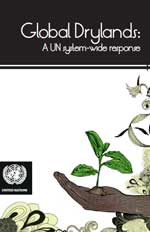 Global Drylands: A UN system-wide response
Global Drylands: A UN system-wide response
United Nations Environment Management Group. October 2011
This report focuses on the importance of the drylands issue on the global agenda and its relation to other issues, including climate change, food security and human settlements. The report illustrates the many ways in which the UN system is identifying opportunities to mainstream the drylands agenda into the policy-making process. It sets out a common vision and agenda for UN-wide action on dryland management and its role in addressing climate change and food security through a positive development and investment approach. The report is aimed at a number of audiences, with certain objectives: (1) UN agencies themselves, to clarify the commitment made to drylands and act as a reference guide; (2) Governments of developed and developing countries, as a normative guide on the UN's position on, and commitment to, the development of drylands; (3) The private sector and donors, to encourage and inspire them to think about the viability and unique opportunities presented by drylands, and (4) Civil society, to encourage advocacy on the development of drylands, and empowerment of their populations.
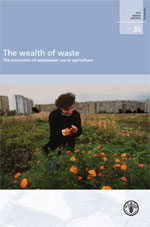 (The) Wealth of Waste: The Economics of Wastewater Use in Agriculture [
(The) Wealth of Waste: The Economics of Wastewater Use in Agriculture [ - 1.86 MB]
- 1.86 MB]
Food and Agriculture Organization (FAO). September 2010
The use of reclaimed water in agriculture is an option that is increasingly being investigated and taken up in regions with water scarcity, growing urban populations and growing demand for irrigation water. This report presents an economic framework for the assessment of the use of reclaimed water in agriculture, as part of a comprehensive planning process in water resource allocation strategies to provide for a more economically efficient and sustainable water utilization. The case material presented provides a good field testing for the approach proposed.
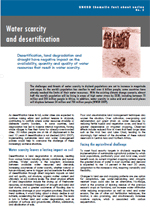 Water scarcity and desertification [
Water scarcity and desertification [ - 528 KB]
- 528 KB]
United Nations Convention to Combat Desertification (UNCCD). 2009
This paper introduces the main challenges and threats of water scarcity to dryland populations and the role of the UN Convention to Combat Desertification with regard to Sustainable Land and Water Resources Management.
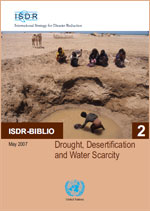 Drought, Desertification and Water Scarcity [
Drought, Desertification and Water Scarcity [ - 2.04 MB]
- 2.04 MB]
United Nations International Strategy for Disaster Reduction (UNISDR). 2007
This document gives an overview of literature covering drought, desertification and water scarcity.
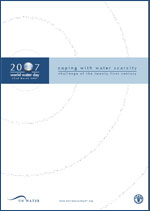 Coping with water scarcity. Challenge of the twenty-first century [
Coping with water scarcity. Challenge of the twenty-first century [ - 458 KB]
- 458 KB]
UN-Water, Food and Agriculture Organization (FAO). 2007
Produced on the occasion of World Water Day 2007, which focused on the issue of water scarcity, this document introduces the multiple dimensions of water scarcity and how it can affect all social and economic sectors and threaten the sustainability of the natural resources base.
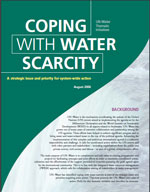 Coping with water scarcity. A strategic issue and priority for system-wide action [
Coping with water scarcity. A strategic issue and priority for system-wide action [ - 474 KB]
- 474 KB]
UN-Water. 2006
UN-Water has identified coping with water scarcity as part of the strategic issues and priorities requiring joint action. This note presents the UN-Water joint plan of action (PoA) for this thematic initiative and describes its elements. It also provides different examples of the ways in which coping with water scarcity can affect the achievement of the Millennium Development Goals (MDGs).
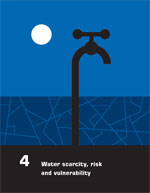 Human Development Report 2006. Chapter 4 [
Human Development Report 2006. Chapter 4 [ - 1.59 MB]
- 1.59 MB]
United Nations Development Programme (UNDP). 2006
Chapter 4 of the Human Development Report 2006 focuses on water scarcity, risk and vulnerability related issues. The chapter discusses how perceptions of water security today are heavily influenced by ideas about scarcity, presents the different dimensions of water scarcity and different scenarios.
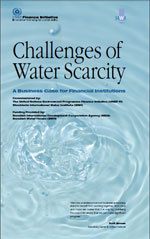 Challenges of Water Scarcity: A Business Case for Financial Institutions [
Challenges of Water Scarcity: A Business Case for Financial Institutions [ - 2.02 MB]
- 2.02 MB]
United Nations Environment Programme – Financing Initiative (UNEP-FI), SIWI. 2005
This report, based on a review of close to 20 cases of projects and investments mainly in Africa and Latin America, and supplemented with interviews with practitioners from both development and commercial financial institutions, concludes that there is a business case for improving risk management tools, which can specifically be related to the risks borne by water scarcity. While each organization must relate to water in its own capacity, the business case for the financial sector comes from acknowledging the potential risks associated with water scarcity and seeking possible opportunities for mitigating these risks.
Water scarcity around the world
Africa
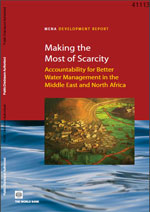 Making the Most of Scarcity. Accountability for Better Water Management Results in the Middle East and North Africa
Making the Most of Scarcity. Accountability for Better Water Management Results in the Middle East and North Africa
[ - 428 MB]
- 428 MB]
Executive summary [ - 141 KB]
- 141 KB]
World Bank. 2007
This report addresses the issues of the political economy of water reform and stresses the importance of "beyond the sector" policies. It analyzes the factors that drive the political economy of water reform and shows how some of them are changing in the MENA region in ways that could open up opportunities for water reform. The report discusses how the challenges and opportunities of the increasingly global economy may change the dynamics of water policy and how the changing demographics of the region (such as rapid urbanization, and increased education levels) might affect demand for water services.
Asia
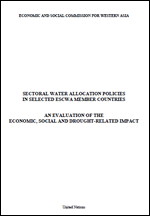 Sectoral water allocation policies in selected ESCWA member countries. An evaluation of the economic, social and drought-related impact [
Sectoral water allocation policies in selected ESCWA member countries. An evaluation of the economic, social and drought-related impact [ - 589 KB]
- 589 KB]
United Nations Economic and Social Commission for Western Asia (UNESCWA). 2003
It is intended that this study constitute both a reference document for policy- and decision-making processes relating to the management of water supplies in the ESCWA region, and an evaluation tool for decisions that have already been made regarding the allocation of water resources to various sectors. As such, its beneficiaries will be primarily policy and decision makers involved in the daily management of the ESCWA region's diminishing water resources. It is hoped that the study will also be of use to other professionals in the field, and will inform the general public on the issues surrounding sectoral water allocation and how optimal allocation can ensure sustainable, equitable and efficient use of the region's water resources.
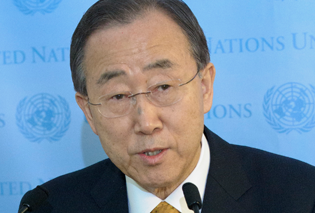
"All are places where shortages of water contribute to poverty. They cause social hardship and impede development. They create tensions in conflict-prone regions. Too often, where we need water we find guns. [...] There is still enough water for all of us - but only so long as we keep it clean, use it more wisely, and share it fairly"
Ban Ki-moon, UN Secretary General
>> Kenya: Water Scarcity
UN in Action
Place: Kenya
Year: 2011
Duration: 3min48sec
In Kenya, the International Atomic Energy Agency is helping farmers make the most of limited water resources. Innovative irrigation and nuclear techniques enable communities to grow stronger crops while protecting the environment.
>> Water scarcity
Food and Agriculture Organization of the United Nations (FAO), July 2009
Duration: 3min27sec
Some quick facts about water and water scarcity. What is the problem, which are the consequences, how to handle it and live with it.
>> (The) Last Kankan of Nakhchivan
UNTV 21st Century
Place: Azerbaijan
Year: 2009
Duration: 9min04sec
Water scarcity has become one of our greatest challenges. In less than twenty years, nearly two billion people could face water shortages. But one country - Azerbaijan - which sits between Europe and Western Asia - has come up with an ingenious solution to its water crisis.
Copyright | Terms of use | Privacy notice | Site Index | Fraud alert | Help





